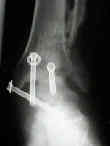
- See: Sub-Talar Fusion
Tibial-Talar-Calcaneal Fusion
- Discussion:
- for pts w/ well-aligned fusion, walking gait in appropriate shoe is almost normal;
- expect 16% decrease in gait velocity and 3 % increase in oxygen consumption;
- running gait or walking in rough, uneven ground is more difficult and vaulting or asymmetry is noticeable;
- in pt w/ ankle fused in optimal position, compensatory increase in motion at midtarsal joints is
expected, if they are not arthritic;
- some patients w/ ankle arthritis and anterior osteophytes (which block dorsiflexion) will already show evidence of midfoot sag (as the midfoot attempts to compensate for lack of dorsiflexion);
- failure to place the ankle in the optimal position will often lead to a poor clinical result;
- outcomes:
- in the report by Coester LM, et al, the authors reported a clinical and radiographic review to determine the effect of ankle arthrodesis on the development of osteoarthritis in other lower-extremity joints;
- 23 patients who had had an isolated ankle arthrodesis for the treatment of painful post-traumatic arthritis of the ankle were followed for a mean of 22 years (range, 12 to 44 years) after the operation;
- at a mean of 22 years, the majority of the patients had substantial, and accelerated, arthritic changes in the ipsilateral foot but not the knee;
- although ankle arthrodesis may provide good early relief of pain, it is associated with premature deterioration of other joints of the foot and eventual arthritis, pain, and dysfunction;
- ref: Long-Term Results Following Ankle Arthrodesis for Post-Traumatic Arthritis.
- in the report by Frey C, et al, the authors reviewed 15 years of experience with ankle fusions, specifically addressing the underlying etiology of ankle pathology, incidence of nonunion, and associated predisposing conditions that can lead to nonunion;
- 78 ankle fusions, performed between 1975 and 1990, were reviewed for this study;
- average follow-up was 4 years;
- patients with nonunion were evaluated separately to look at the predisposing factors that may have lead to nonunion;
- factors associated with nonunion included fracture type, evidence of avascular necrosis, infection, major medical problems, and open injuries;
- factors that were not associated with nonunion included age, past history of subtalar or triple arthrodesis, and technique;
- ref: A review of ankle arthrodesis: predisposing factors to nonunion.
General Orthopaedics: Ankle Arthrodesis: Problems and Pitfalls.
Methods and Follow-Up Statistics on Ankle Arthrodesis. Symposium.
Long-term results of tibiotalar arthrodesis.
Comparative analysis of ankle arthroplasty versus ankle arthrodesis.
Ankle arthrodesis in children.
Salvage of nonunion following ankle arthrodesis for failed total ankle arthroplasty.
Compression arthrodesis of the ankle. Evaluation of a cosmetic modification.
Complications and long-term results of ankle arthrodeses following trauma.
Ankle arthrodesis. Long-term follow-up with gait analysis.
Long-term results following Lambrinudi arthrodesis.
Arthrodesis of the ankle in patients who have rheumatoid arthritis.
Transfibular compression arthrodesis of the ankle joint.
Ankle arthrodesis placement of cannulated screws.
A roentgenographic technique to evaluate and document hindfoot position.
Complications and long-term results of ankle arthrodeses following trauma.
Arthrodesis of the diabetic neuropathic ankle joint.
Total Ankle Arthroplasty: a Unique Design. Two to twelve year follow up.
Arthrodesis of the Ankle: A critical analysis.
Clinical Outcome of Arthrodesis of the Ankle Using Rigid Internal Fixation with Cancellous Screws.
Outcome after single technique ankle arthrodesis in patients with rheumatoid arthritis.


